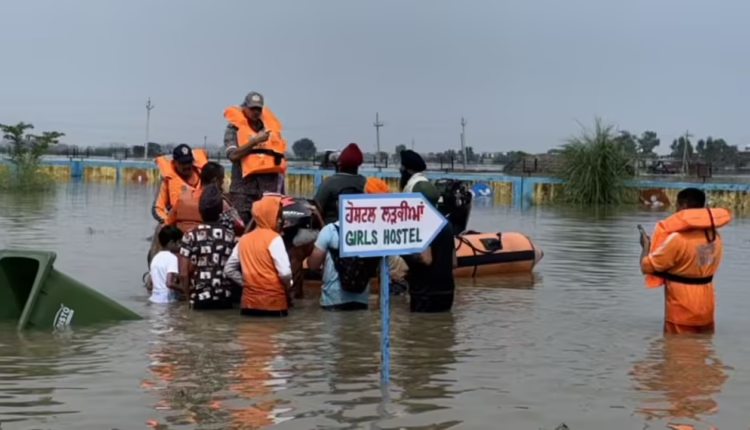Punjab Reels Under Historic Flood Fury Again: Echoes of 1988 Tragedy Haunt the State as Relief Efforts Intensify
Chandigarh/Gurdaspur:
Punjab, India’s agricultural heartland and frontline border state, is once again in the grip of devastating floods that have swallowed thousands of acres of farmland, submerged entire villages, and left families clinging to memories of the catastrophic floods of 1988.
For many, this year’s deluge is not just a natural disaster but a grim reminder of a nightmare they thought was buried decades ago.
Rivers Sutlej, Ravi, and Beas have turned violent under the relentless onslaught of monsoon rains, forcing residents across districts like Gurdaspur, Pathankot, Hoshiarpur, Kapurthala, Amritsar, Tarn Taran, Fazilka, Ferozepur, and Ludhiana to flee their inundated homes.
Farmers are watching helplessly as their paddy fields—the backbone of Punjab’s agrarian economy—vanish under muddy waters. This is worse than anything we have seen before.
The water came so suddenly that we couldn’t even save our livestock. The government must act faster,” laments Gurnam Singh, former sarpanch of Dugri village near the Ravi river in Gurdaspur.
While the official death toll remains in single digits so far, devastation in neighboring Pakistan has claimed over 200 lives as shared rivers wreak havoc across borders.
Himachal Pradesh and Jammu & Kashmir, upstream states, are also reporting widespread destruction, adding pressure to Punjab’s already fragile situation.
Punjab’s Forgotten Wound
The current crisis draws inevitable parallels with the catastrophic floods of September 1988, an event etched deeply in Punjab’s collective memory.
Back then, Punjab witnessed between 600 and 1,500 deaths (depending on estimates), and nearly 75% of its kharif crop was destroyed.
Entire villages disappeared, and bodies floated across the border into Pakistan, painting a grim picture of nature’s fury.
Allegations of man-made mismanagement haunted the disaster. The Bhakra and Pong dams, critical to controlling Punjab’s river systems, were accused of being poorly managed.
The Bhakra Beas Management Board (BBMB) had forecasted 120 mm rainfall, yet over five times that amount lashed Punjab between September 22–26, overwhelming the dams and forcing emergency gate openings.
At the height of Punjab’s separatist insurgency, conspiracy theories ran rampant.
The BBMB chief, Major General BN Kumar, was assassinated in November 1988, allegedly by militants, making him one of the highest-ranking military officers to fall during that turbulent era.
The tragedy of 1988 was not just a natural calamity but a socio-political flashpoint, leaving scars on Punjab’s psyche for decades.
A Border State Under Siege by Nature and Intrigue
Punjab is not only India’s breadbasket but also a strategic shield against Pakistan’s border hostilities and subversive tactics.
The ongoing floods highlight Punjab’s dual vulnerability: its dependence on agriculture and its critical role in national security.
Pakistan’s repeated attempts to destabilize border districts through infiltration, arms smuggling, and cross-border drug trafficking add to the woes of a population already reeling from floods.
Experts warn that weakened infrastructure in flood-hit areas could create opportunities for further destabilization.
Relief, Rescue, and Rehabilitation: Government Mobilizes Resources
Punjab Chief Minister Bhagwant Mann has called the situation “unprecedented” and assured full state support.
Touring flood-hit regions, he directed Deputy Commissioners of affected districts to accelerate rescue and relief operations. “We are working around the clock to ensure food, shelter, and safety for every family affected,” Mann stated.
The state government has deployed National Disaster Response Force (NDRF) and State Disaster Response Force (SDRF) teams, while boats and helicopters are being used to airlift stranded villagers.
Relief camps have been established to provide emergency shelter, food supplies, and medical care.
The central government, too, has stepped in, allocating funds for immediate flood relief under the National Disaster Response Fund (NDRF).
Union Home Ministry officials confirmed the dispatch of rapid response teams and pledged to assess long-term infrastructural damage for rehabilitation.
An Economic Blow to India’s Granary
Punjab, known as the “Granary of India”, contributes heavily to the country’s food security, producing a significant portion of India’s wheat and rice.
Floods during the paddy season could derail procurement and supply chains, impacting markets nationwide. Experts warn of crop loss running into thousands of crores, with many marginal farmers on the brink of ruin.
The damage is not limited to agriculture. Road networks, irrigation systems, power lines, and schools across villages are crippled, pushing back years of infrastructural progress.
People’s Resilience Amid Crisis
In Amritsar’s flood-hit Ajnala sub-division, villagers like Manpreet Singh recount their trauma: I was a child during the 1988 floods and still remember the horror.
This time, it is even worse. Entire villages are submerged. We are fighting for survival again.”
Volunteers and NGOs have stepped in, distributing food, clean water, and medicines while villagers form community rescue squads, reinforcing Punjab’s enduring spirit of resilience.
A Call for a Long-Term Plan
Experts emphasize the need for river basin management reforms, dam modernization, and floodplain zoning to mitigate future disasters.
With climate change amplifying extreme rainfall events, Punjab’s strategic importance as both a food producer and border sentinel makes flood preparedness a national priority.
For now, Punjab fights a familiar battle—against nature’s fury, logistical hurdles, and historical scars.
The resilience of its people and coordinated government efforts will determine how quickly this agricultural powerhouse can return to feeding India and guarding its borders.
#PunjabFloods #Punjab2025 #ClimateCrisis #IndiaAgriculture #FloodRelief #BhagwantMann #BorderState #NationalSecurity #FarmersFirst #DisasterManagement

